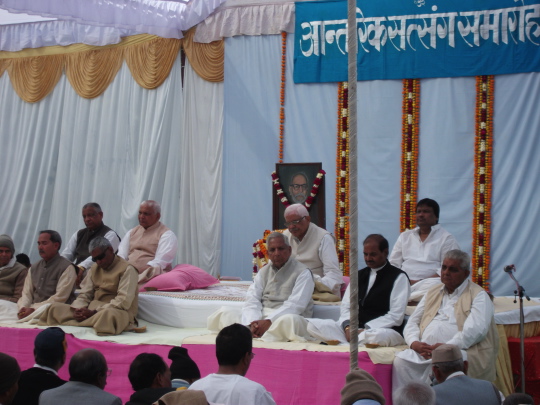
Normally, it’s not too difficult to gain a reasonably dispassionate perspective about any organization; there are people within and without willing to put forward their views. But when the organization is little known and also prefers to avoid publicity, the task becomes a challenge; it takes time to ferret out the right sources of information. So it was when I set out to write about Ramashram Satsang, Mathura (RSM) .
RSM has been in existence mostly in northern India for the last eighty years, yet the movement appears content in its little-known status. As Anand Prakash Kulshrestha, 59, an income-tax official in Unnao, near Lucknow, said: “Our movement is not for show. We want solid members, committed members. We don’t talk about RSM outside nor do we advertise ourselves in any form.”
But, when roughly half of India’s population is less than 30 years old and browses all kinds of media for information, can RSM afford to ignore publicity?
“Look, young or old, if anyone is genuinely interested in spiritualism, he or she will make enquiries. They will join a movement of their choice. It’s not that RSM is the only option.”
Fair enough. Still, RSM hasn’t underestimated the power of the printed word. The organization brings out a fair amount of pamphlets and booklets in both Hindi and English. Also, since 1933, it has published a monthly journal in Hindi called Sadhan. In fact, I met Anand at a celebration at his house in honor of his cousin, late Om Prakash Biral, who was closely associated with the journal.

The Satsang or Congregation of Spiritually Inclined
My own tryst with RSM came about in a series of serendipitous steps. First, when I moved to Lucknow last year, KK Srivastava, 79, a former audit officer with the Mahatma Gandhi-inspired Khadi Village Industries Commission, offered me accommodation. I readily accepted because I liked what I saw of him and his family. Second, I noticed that he and his wife, Manorama, 69, disappeared for about two hours every Sunday morning. When I asked what it was that engaged them for those two hours, he said, “Ramashram Satsang. We have a small meeting in the neighborhood. Want to come?”
The satsang or congregation of the spiritually inclined was at the house of Madan Mohan Bhatnagar (his grandson lives there now), a close disciple of Dr. Chaturbhuj Sahay, who founded Ramashram Satsang way back in 1930 at Etah. (Dr. Sahay shifted to Mathura in 1951, an hour’s journey by road from Agra, the city of the world famous Taj Mahal). Bhatnagar was instrumental in developing the RSM movement in Lucknow, and Srivastava and his wife often remember him with gratitude. “He was our guru. Whatever we have today is due to his grace.”
As I was busy with other writing work I couldn’t go to the satsang, but some months later, Srivatsava dragged me to another organized on Basant Panchami, the day signaling the onset of spring in India. The event was held in an upscale district called Indiranagar. Even before I settled down on the carpeted ground with four hundred or so other satsangis, both men and women, almost all middle-aged or elderly, with a sprinkling of youth, I sensed a soothing aura about the place-the flowing white silks of the marquee overhead, birds trilling outside, the moderate chill of a February morning, and the unostentatious voice of a woman singing a tribute in rustic Hindi.
The tribute was to Dr. Chaturbhuj Sahay, who is of course no more. Nor is any of the first generation of his closest disciples. It’s the second and third generations who are propagating his teachings, mostly in northern India and countries like USA, Germany, Sweden, and Canada.
“We are not in southern India because a number of movements are already there, like Sathya Sai Baba, Art of Living of Ravi Shankar, Isha of Sadhguru, and Oneness of Amma-Bhagwan. People seem happy with them. Good. We don’t have a problem,” said Prabhu Dayal Sharma, 78, with a gentle laugh. He and his brother, Krishna Kant, 74, are the top leaders or achars of the RSM strand based in Tundla, 25 kilometers south of Agra. This strand evolved from their late father’s, Pundit Mihi Lal’s, close association with Dr. Sahay. Mihi Lal is acknowledged by RSM to have made the ‘most important and extensive’ contribution to the proliferation of the movement in India after Dr. Sahay’s demise in 1957.
Both Prabhu Dayal and Krishna Kant were at the satsang, squatting on either side of a portrait of Dr. Sahay on a cushioned dais. Several assistants flanked them. One Devraj Singh, a retired officer from the local government secretariat, wearing close-fitting sunglasses, spoke eloquently. He related a mythological story about Indrani, wife of the god of heavens, Indra, who obtained enlightenment from the goddess of knowledge, Saraswati, on this specific day eons ago. “If you look around, nature seems to reflect that enlightenment in its own beautiful way. So, Basant Panchami is a fortunate occasion for us satsangis to gather here, to reflect on the supreme power, to reflect on ourselves, our inner selves.”
After all, Devraj continued, his sunglasses flashing from side to side to take in the audience, didn’t Lord Krishna advice the Pandava warrior Arjuna on a vital precept of Hindu spiritualism? – Those that are peaceful both in joy and sorrow are in satsang with me. Devraj also talked about Gautama Buddha, who, when approaching death, told his disciples not to fret-because that which never was will cease to be, and that which was will continue to be.

Evidently, RSM is not shy of drawing inspiration from diverse religions. In fact, Dr. Sahay was the closest disciple of Ramchandra Lala of Farukkabad (RSM is named after Ramchandra), who in turn is believed to have gained enlightenment from a Sufi saint, Maulana Shah Fazal Ahmad Khan, in the early 1900s (when Ramachandra was only 18).
“Lalaji took the best of both Hindu and Sufi elements. Sufism [1] has a lot of Vedic aspects,” said Raghunath Prasad, a retired executive who flew in from Chicago for a major satsang at RSM headquarters in Mathura. “Lalaji believed that truth is nobody’s monopoly. Yet he was not keen on spreading his philosophy, although his movement continues to exist separately in Shahjahanpur in a small way. His reluctance was due to the political and communal turmoil of those colonial days— nationalist feelings were being stoked by Tilak, Gokhale, Gandhi, and others to oust the British from India. Then there was a lot of discontent between Hindus and Muslims, with each distrusting the other, and the British playing on that. However, Dr. Sahay convinced Lalaji that he would work to spread the philosophy. But, yes, the movement grew very slowly, because of the political situation and also because of lack of publicity. Dr. Sahay didn’t want publicity.”
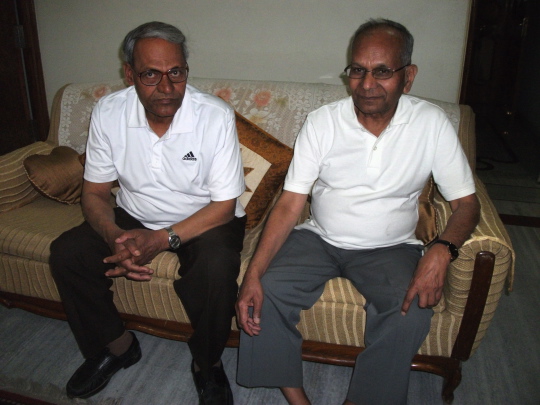
The Meditation
After another speaker dwelt on the Ten Principles [2] of the Ramashram Satsang philosophy, there was a call for meditation. Srivastava had told me something about the Ramashram Meditation Technique: that it’s practiced twenty minutes each in the morning and evening, that the process involved imagining your chosen guru whose heart radiates a ray of light and enters your own heart. The light, of course, as in several religions, symbolizes divinity and is believed to bring you closer to the guru who is considered to be a representative of the Divine.
I had personal experience of another technique, Transcendental Meditation or TM, made popular by Maharishi Mahesh Yogi during the 1960’s and 70’s. Maharishi enjoyed a good amount of success in spreading his TM technique and one reason was he unleashed regular publicity blitzkriegs, full page advertisements in newspapers and magazines, something unheard of those days in spiritual movements. I remember being captivated by one such ad and paying fifteen rupees or so for getting initiated into the technique in Bangalore, southern India.
His transcendental meditation technique, also of twenty minute duration twice a day, involves sitting in a comfortable posture, preferably in a dark room, with eyes closed and repeating a mantra silently in the mind and gently reining the mind back to the mantra should other thoughts surface. The repetition of the mantra leads to a stage where it dissolves and one experiences a state of extreme restfulness even as all senses are tuned up to peak alertness.
In its simplest effect, Maharishi claimed that regular practice of TM would help the practitioner combat the rigors of daily living in a ‘creative’ manner-in fact, his organization in India was initially called the Science of Creative Intelligence. In the broader aspect, Maharishi extolled that if a ‘critical mass’ (1%) of our population practices TM regularly, a ‘Golden Age of Enlightenment’ would dawn on India; an era that would see heightened consciousness, falling crime rates, greater cooperation between government and people, and all round improvement in living conditions. Poverty, corruption, illiteracy, poor healthcare, and all the other ills that bedeviled India for so long would be consigned to the dustbin. But, later, Maharishi started dabbling in advanced siddhi techniques (one of which was supposed to enable the practitioner to ‘fly’) and also setting up a kind of government, complete with ministers and secretaries, that offered consultancy to other governments! It all became a rather far-fetched exercise and started to lose support amongst his own followers. However, regarding the TM technique, I for one still vouch for its effectiveness.
So, while the satsangis practiced their ray-of-light meditation technique, I slipped into silently chanting the mantra given to me thirty-five years ago. This was the first time I was meditating along with hundreds of others. Silence ensued. Just the occasional honk of a passing car or a bird fluttering off from a tree. Even the few children who accompanied their parents sensed something serious was afoot and stopped their frivolity. It was a memorable experience. Then the same woman’s voice nudged us back into the real world with another song in Hindi. Prabhu Dayal was to later tell me, “Regular meditation, regular satsangs, regular communication over phone and letters with like-minded people…these are what we advocate for developing the inner self. It’s simple logic-company of bad people will cultivate bad thinking, company of good people will cultivate good thinking.”
Next, four volunteers materialized with bags in their hands near the dais. Like farmers scattering seeds in a freshly tilled land, they came striding through the audience, handing out prasad left and right-golden brown sweet samosas. A sensual flourish to matters spiritual. “Oh, there is lunch too,” said Srivatsava with visible relish.
The leaders stepped down from the dais. People rushed to touch their feet, seeking blessings. Prabhu Dayal and Krishna Kant didn’t look affected by all these pranams; they inched forward whenever they could. Srivastava introduced me to Prabhu Dayal. He bid me visit the Mahashivarathri Celebrations at Mathura in March. “First come to Tundla where I live,” he said, his eyes full of merriment behind his bifocals. “We’ll talk there.”
The Play of Ego
March was some weeks away. So, I went to meet Dr. Brijesh Kumar Shukla, head of the Sanskrit Department at Lucknow University and an authority on the history of Hindu religion.
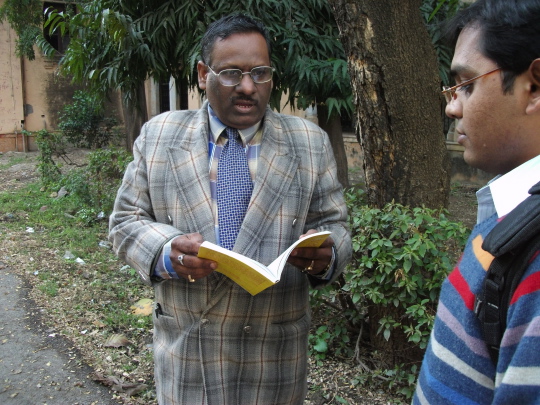
“RSM seems to follow the philosophy of the Bhakti Movement (emotional devotion to the Supreme) made famous by the Twelve Alwars or poet saints of Tamil Nadu who lived between the 6th and 9th Centuries AD,” he said. “The Alwars’ Tamil poems were exhaustive tributes to the greatness of Vishnu and his avatars, especially Krishna, and were meant to neutralize the growing influences of Jainism and Buddhism and rejuvenate Hinduism.”
The Alwars came from a diverse strata of society (one Alwar is believed to have been a woman-Andal– and quite a few were from the lower caste of Shudras of the four-tiered caste system [3] which still exists amongst Hindus). These poet saints collectively authored the Dravidnamnay-most importantly, the Nalayiram Divya Prabandham or 4000 verses–considered equivalent to the Vedas.
The quintessence of the Bhakti movement was that rituals and sacrifices as prescribed by the Vedas (India’s most ancient scriptures, about 2500 years old, and believed to be the starting point of all recorded history of this country) weren’t necessary to travel the spiritual path, caste and gender were immaterial, but total surrender to a realized soul was essential to experience divinity. The Bhakti movement gradually spread northwards from Tamil Nadu and caught the imagination of the rest of India.
“Bhakti was born in Tamil Nadu, blossomed in Maharashtra, aged in Gujarat, and danced in Vrindavan,” said Dr. Hari Mohan Malviya, Director of the Vrindavan Research Institute. Dr. Malviya was to later elaborate on key aspects of the spiritual and societal scenario of the 19th and 20th Centuries, corresponding roughly to the period when the Sufi saint, Maulana Shah Fazal Ahmad Khan, and his disciples in succession, Ramchandra Lala and Dr. Chaturbhuj Sahay lived. Vrindavan, about 25 kilometers from Mathura, is a small town of beautiful temples.
This brings us to the great Ramanujacharya of the early 11th Century, who authored brilliant scriptural treatises like Brahm Sutra. He was not only a huge proponent of the Bhakti movement but also a believer in the equality of all castes. In fact, as a young man he eulogized a temple cleaner belonging to the lower caste who was utterly devoted to the idol of Vishnu. The cleaner, horrified at the young Brahmin Ramunuja’s admiration, mistook it as mockery. Such nobility of outlook was to remain a hallmark of Ramanujacharya all his life. He even left his wife when she, still holding fast to her orthodox views, disparaged the ‘lowly born’ wife of one of his gurus. Clearly, a case of man not being a prophet in his own family! What then of an entire society outside the family, as happened later when the Vaishnos of Ramanujacharya split into two streams-the Vadagalai and Thengalai sects and differences in rituals, thoughts, caste, tattoos and marks and even attire crept back into society. Perhaps Ramanujacharya’s remains, believed to be buried in the Srirangam Temple in Tamil Nadu in southern India, squirms every now and then in utter disappointment.
Ramanujacharya, while following the basic tenets of the Bhakti movement, considered Vishnu as the Supreme Being, not Shiva as propounded by Adi Shankaracharya of northern India (7th Century AD). Of course, Ramanujacharya’s work covers many more major aspects of Hindu philosophy which are outside the scope of this article. Suffice to say that he polarized Hinduism in a way never done before: worshippers of Shiva and worshippers of Vishnu-advaita (non-duality or absolute oneness of the supreme; everything else is temporary and illusory) and vishishtadvaita (qualified non-dualism or several unique attributes of the Supreme; everything–the universe and the souls–is real as they issue from the supreme).
“Actually, although one could say that Ramunjacharya did polarize Hindus, they were already divided since ancient times into the kind of gods they considered supreme,” explained Dr Shukla. “Worshippers of Vishnu (Vaishnos), Shiva (Saiyos), Durga (Shaths), Sun (Saurs), and Ganesha (Ganpats). Of these only the first three groups survive today in a major way. Worshippers of Ganesha, who is believed to be actually the son of Shiva, are less and especially confined to Maharashtra. We don’t have worshippers of the sun-the Saurs-anymore.”
Dr. Shukla spoke some more of the major turnings points that impacted Hindu religion down the centuries. “Worshipping many gods was basic to Indian culture right from the Vedic times. Our ancients worshipped the several elements-earth, fire, air, water, light, animals etc.-as gods. Whenever they wanted the largesse of a specific element, that particular god was worshipped, sacrifices of many kinds offered. But yes, they did conceive one god more important than all the others. Brahma, the Creator.”
Then the Ram Bhakti (devotee of Lord Ram) movement arrived. This was around the time of King Rama of Ayodhya, about 7300 BCE (according to Hindus). Rama came to be considered as an avatar of Lord Vishnu because of his nobility as son, king, and husband, his unshakeable resolve of meting out punishment to the evil as personified by the demon Ravana who abducted Rama’s wife, Sita. [4] Worship of Rama took pre-eminence over other gods and was vigorously advocated by saints like Tulsidas and Surdas.
The next major change was the era of Krishna (about 3300 BCE) also considered an avatar of Lord Vishnu. Krishna helped the five Pandava brothers fight their hundred cousins, the Kurus, in the great Mahabharata war for justice. Krishna showed his brother-in-law, Arjuna, the master archer of the Pandavas, the dharmic or righteous way of life. This was the sermon as contained in the Bhagavad-Gita [5] which Mahatma Gandhi however considered as a treatise on the tussle between evil and good in the hearts of everyone, and equivalent to Christ’s Sermon on the Mount. Since there were a huge number of stories and legends woven around Krishna, and poet saints like Mirabai authored a number of songs in his honor, people found it more attractive to worship him. Rama faded into the background.
Next were the great Hindu renaissances, the Bhakti Movement of the Alwars and the Vaishnovism of Ramanujacharya. Although they didn’t displace Shiva worship as extolled by Shankaracharya, they had a lasting impact down the centuries all over India, and inspired a number of spiritual figures.
In this context, Ramashram Satsang could be viewed as a movement that strives to bring together salient points of several religions in a unified approach towards spiritualism. Perhaps therein lays its difficulty in spreading such an evolved view rapidly amongst society. For example, not all members of KK Srivastava’s own family believe in RSM. “It’s their choice,” he said, but a tremor of disappointment showed in his tone.
When I mentioned the meditation technique of RSM to Dr. Shukla, he explained it as just one of several techniques. “Some focus inward, some, outward. Some have eyes closed, and some, eyes opened. In the inward process, for example, there are techniques which require one to focus on chakras or energy centers believed to be resident in the nervous system-in the pelvis, chest, neck, head, and so on. In the Bhagavad-Gita, the nose is mentioned as an energy center. In the outward process, for example, with eyes open, one concentrates on a flame or a raised finger or some other object. The objective of all such techniques is more or less to deliver you to a state of transcendence or siddhi from where you are supposed to experience something deeply spiritual or approximating the divine.”
As a concluding note, Dr. Shukla had this to say: “My personal opinion is that all these movements that have sprung up in the last hundred years or so are just different approaches to a spiritual experience. If you really get down to the bottom of any movement, the raison d’être, you would find the play of ego: our way is better. Sometimes this play is subtle, sometimes loud. That is all.”
He seemed to echo the sentiments of the Registrar of the University, Dr. G.P. Tripati, whom I met earlier. “What is religion? It’s actually how we ought to behave. But religion in India has remained sectarian and ritualistic as in ancient times. These sectarian differences have led to ego clashes and problems. The core values as exemplified by the Bhagavad-Gita seem to have been cast aside.”
The Tundla Experience
The small town of Tundla is a night’s journey by train from Lucknow and I got off at the station at 5.30 am only because the train stopped there for a long time; I was woken by the call of tea vendors shouting ‘Chai…garam chai‘ – tea…hot tea!
Outside, a steady drizzle fell and there were virtually no street-lights. The Ramashram Satsang was a kilometer away on the main road. I boarded a cycle rickshaw. It was a unique experience, entering a new town at the wisp of an amorphous dawn, riding with a bulging suitcase in a three-wheeled manually driven contraption, and the light shower of rain somehow adding to the tension I was already experiencing as I was going to meet the top leaders of a spiritual movement. I couldn’t shake off the feeling that I was alternating between two states of consciousness–a journalist who wanted to be objective, and an insignificant soul who wanted to get close to someone who had experienced a higher power and thereby gain some assurance that I wasn’t all that insignificant.
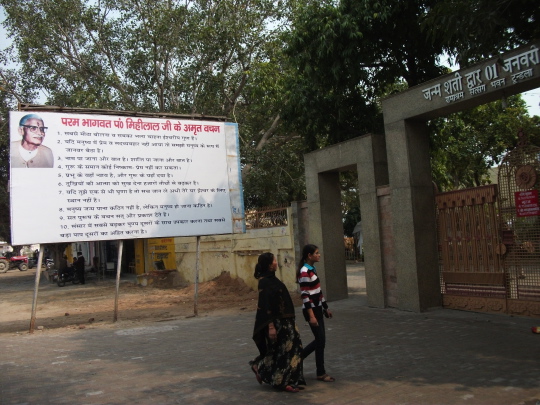
The ashram was a large hall with a garden in front, washroom facilities at one side and a prayer room at the back. The hall acted as a sort of dormitory for devotees. There were about fifty of them, laid out or squatting on jamkhanas or cotton carpets, getting ready for the Morning Prayer that was to be graced by the siblings. In the middle on one side was a bust of the siblings’ father, Pundit Mihi Lal, the close disciple of Dr. Sahay. People went up, stood with folded hands, and bent to touch their foreheads to the bust.
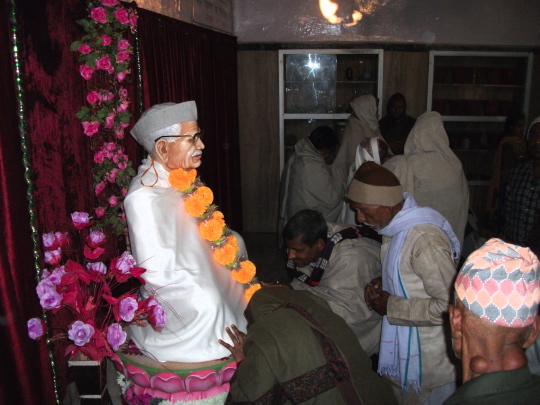
The elderly siblings arrived and bade us accompany them to the prayer hall at the back. Everyone hurried there, keeping their luggage in the hall, but since there was a notice in Hindi that one was responsible for one’s belongings, I lugged my suitcase to the prayer room. I was, it turned out, the only one who had done so. Prabhu Dayal glanced at my suitcase with amusement. For the next forty five minutes, there was prayer, singing, and meditation, much like the Indiranagar satsang. Later, Prabhu Dayal asked me to follow him to his house, “for breakfast and talk”.

His house was about half a kilometer away, and again it was a never-before experience for me: walking behind a guru who was clad in a nine-yard lungi draped in the traditional style, a muffler looped about his neck, and an assistant holding an umbrella over his head as the drizzle was still on. Somehow everything around, the few shops that had opened, the scarce traffic, the motley pedestrians, took on the sheen of an illusion.
Prabhu Dayal’s study, which I had to enter barefoot, was compact, unlike the rest of the house which seemed to extend in every direction on its own. And the first thing that he told me was to keep my suitcase in a mini cloakroom at the back. It was with alacrity and relief that I did so. And then, at the breakfast table where his charming grand-daughter, Shruti, served us porridge, buttered toast, cookies and tea, he said, “Ask me anything. Be frank. I will also be frank.” What better invitation does any journalist need?
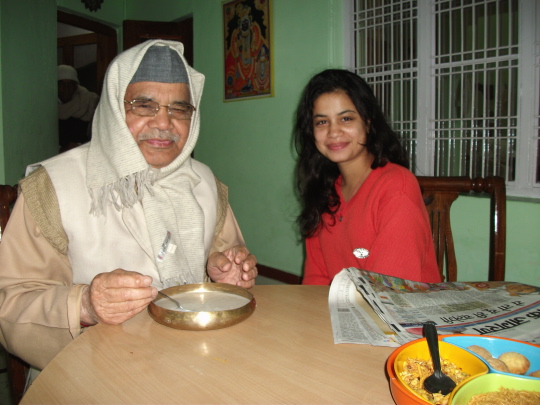
What spiritual movements prevailed in the 1930s when Dr. Sahay founded RSM?
“There were four main movements going on at that time. One was of course the Bhakti movement, then the Sayos and Shaath movements all over northern India, and the Brahmo Samaj that started from West Bengal. But our movement was probably the easiest way to discover divinity irrespective of caste, creed, or even religion.”
He went on to echo Dr. Shukla of Lucknow University. “The thing is everyone wants to experience divinity, that goal is common. It’s like a cool and refreshing river people are eager to dip into. What happens? A lot of waves are created but finally settle down quietly. It’s the same with all religions. Every religion creates a lot of waves but in the ultimate analysis, the goal is the same place. Bliss. Peace. Divinity. Only thing is that we believe it is easier to reach that place when you take the help of one who has already experienced it. Meaning, a guru or a saint. A guru is incarnation of god. God becomes man so that man may become Man. What did Krishna say to Arjuna on the great battlefield of Kurukshetra? Keep me with you. Victory will be yours. Don’t be afraid of anyone. Just go and do your work, your duty. So, when we have faith in our guru, victory is ours every time. It also means that trying to succeed by yourself is difficult.”
And yet, Prabhu Dayal was at pains to explain that RSM didn’t believe in criticizing any other movement, saint, or guru. “Guru Maharaj used to say that every guru is right in his own way. Each one has his own particular type of food. Only the taster knows how delectable the experience is. But he also said, ‘Be aware of other paths but follow your own. That way complete knowledge is yours. There would be no confusion.'”
How relevant is RSM in today’s society?
“Most relevant today when compared to any other time. Why? Because this is the age of science and everybody wants facts. Our Guru Maharaj, Dr. Sahay, had foreseen this. He said that the heart is the laboratory of your judgment. Just think and feel for yourself. You will know exactly what to do. But to arrive at that stage, one must go through a few steps. First is concentration. Forget everything else, just focus on your inner self, what you want to improve. Then meditate, which only means deeper concentration. And finally, realize your duty and work. After all, what is the purpose of life but to fulfill certain duties and tasks assigned by god? Realizing that purpose is the greatest happiness.”
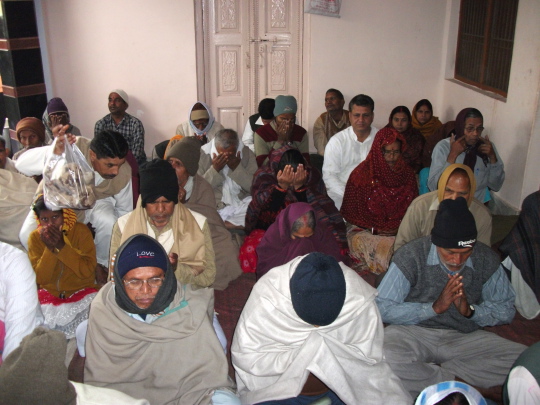
Could he describe his own experience when he guides several hundreds of people on to the path of spiritual realization?
He smiled. “Good question. In words I cannot describe my feelings. It’s indescribable, a kind of super happiness. My father tried to explain it once. It was like a weary traveler on a hot day, visiting a friend’s home and being offered a glass of chilled lemon or fruit juice. How could he explain the experience of drinking that sherbet?”
Prabhu Dayal was immersed in RSM activities from a young age because of his father, Pundit Mihi Lal, but got fully involved from 1992 when he retired from the Railways as Chief Controller. Did he face any severe challenges to his faith in RSM?
“On two occasions. The first in 1986 when my wife expired. She was everything to me. And the second in 1996, when my eldest son expired. That was a bigger shock because he was just 42. He was working with State Bank of India. But RSM actually helped me overcome those shocks.”
How does he coordinate with his brother, Krishna Kant?
“Physically we may appear different, but in heart we are one. Even our thoughts are synchronized. It is due to years of training and practice. We are one with god, there is no other between us. Not even our egos. Because when ego is in, god is out, and when ego is out, god is in. Simple. It’s not some complex rocket science. Why don’t you talk to him too?”
I did that. Krishna Kant is tall, well-built and with a determined gait. In fact, it’s his habit to walk a few paces ahead of Prabhu Dayal, as if cleaving a path for him through crowds of followers. Krishna Kant was in his study, too, poring over some papers, and when we began to talk, he sounded much more enthusiastic than his elder brother, so much so that anyone would think twenty years separated them, not four.
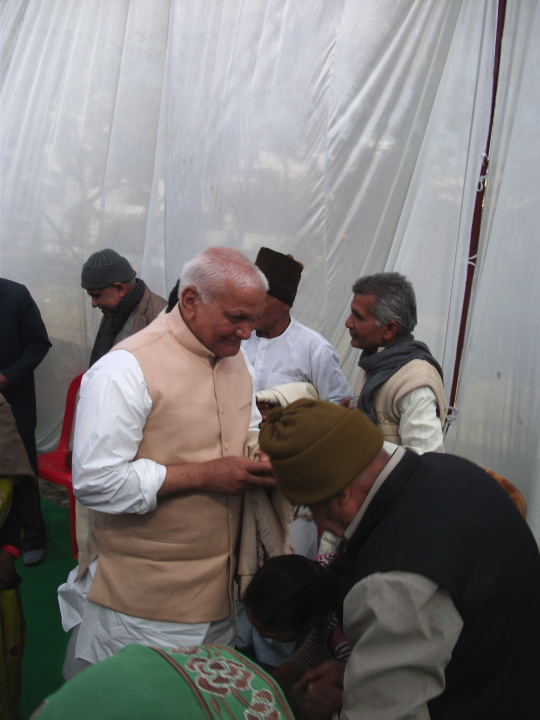
Krishna Kant has traveled to several countries to disseminate the philosophy of RSM-USA, Canada, England, France, Holland, Germany, Mauritius, Thailand, Burma, and Nepal. “Somehow I find that the philosophy fits all people everywhere, which is why it seems to be growing,” he said. “And the second thing is we demand no fee, no registration, it all depends on individual desire and affordability, how much each one wants to give to the organization. That is also one reason why I cannot tell you how many people we have in RSM.”
He narrated an incident where someone in the United States asked him what he thought of modern electronic media, how they can be used for spiritual growth. “I don’t think they can help,” he replied. “They are all sponsored shows, to rake in money. If you want spiritual growth, go find a saint. Sit in front of him. He will give you knowledge and guidance for spiritual growth.”
Another person in Canada meditated for about ten minutes and came to Krishna Kant and said, “Today, I have realized what peace is truly.”
Krishna Kant was in the pharma business prior to full involvement in RSM. “My son is looking after the business now.” He has two other sons and five daughters, all married, and six grandchildren. “In a way, I am free from family bonds. The family does attend the satsang meetings although they don’t have any organizational roles. It depends on them, whether they want to have such roles.”
And then as he ordered tea for me, he wanted to know if I would be attending the Mathura satsang to be held two days hence. I said yes.
“Good,” he said. “You will see RSM in its true colors, its strength and diversity.”
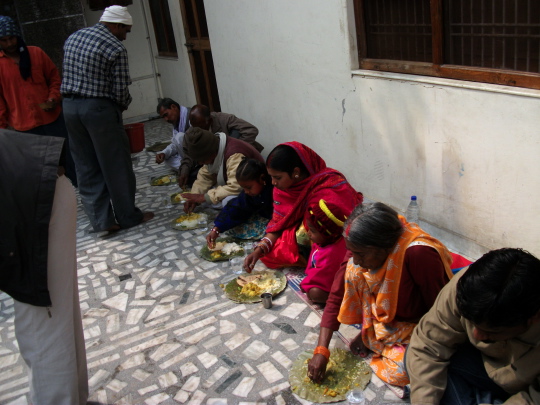
Before I left for Mathura, via Agra and its awesome Taj Mahal, I sat Indian style for a simple meal of rice, chapattis and dal, served on banyan leaves stitched together on the quadrangle floor outside. Shruti appeared in the doorway and watched for a few moments, a half smile playing on her lips.
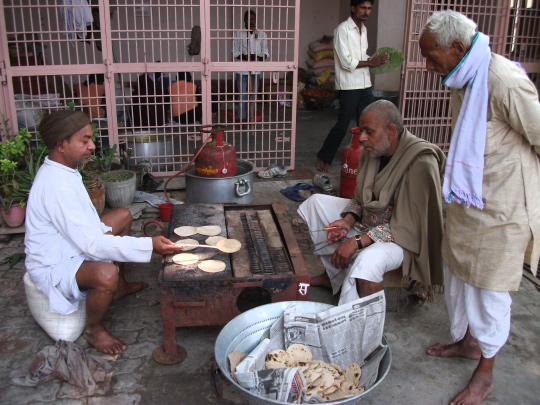
Mathura and the RSM Mela
Mathura, believed to be the birthplace of Lord Krishna, evokes much more than smiles-despair, disbelief, and reverence. A busy little town with contradictions that hit all your five senses–dirty streets and irresistible milk-sweets, garish shopping malls and quaint temples on the banks of the River Yamuna (the Dwarkeesh Mandir is popular), hotels that smell of urine and worse and armies of tourists, both Indian and foreign. You might even get to see a handsome middle-aged man who walks the streets stark naked, morning, afternoon, and night, oblivious to the stares and laughter of passersby. Perhaps he is in a state of consciousness that few of us can reach.
The Krishna temple at his janmabhoomi or birthplace is a grand marble structure built by a scion of the Birla family and has some beautiful sayings from the Bhagavad-Gita to admonish the wayward pilgrim, a couple of which I find hard to refrain from reproducing here:
Homes from which guests go away without having been received even with an offering of a little water are like those holes in the fields which are the homes of jackals.
One may claim proprietorship to as much wealth as required to maintain body and soul together, but one who desires proprietorship over more than that must be considered a thief, and he deserves to be punished by the laws of nature.
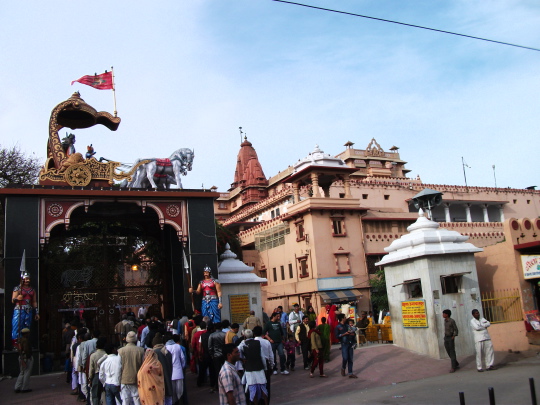
The temple stands cheek by jowl with an imposing mosque built by that vicious Mogul king, Aurangzeb (who imprisoned his own father, Shah Jahan, and captured the throne). Both temple and mosque are separated by barbed wire and electrified fencing and heavily patrolled by armed police. Could the Omniscient Krishna have dreamt that his birthplace would turn into a fortress!
In contrast to opulent marble and machine-guns, the Ramashram Satsang headquarters in Dampier Nagar district is a flat large mansion that invites you to walk in, tarry awhile, meet and talk with people around and spread out a mat on the open lawns and meditate as much as you want. But even this homely atmosphere transformed into a giant mela or fair for three days. About ten thousand people descended from all over northern India and engulfed the lawns and surrounding streets. Added to this there were vendors of every conceivable household item, giving respite to many housewives from the regular meditation sessions that they were called to over the loudspeakers.
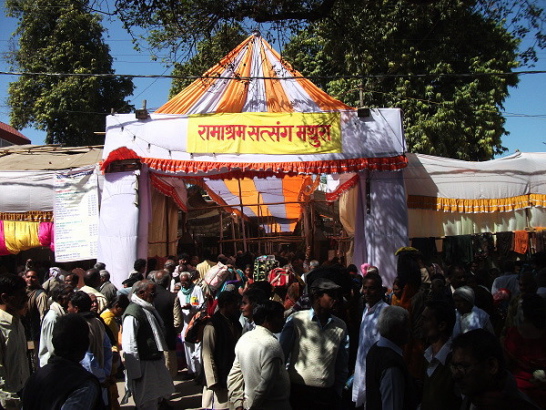
At the mansion itself, while the portico played host to speaker after speaker in the mornings and evenings, the entrance was occupied by stalls dispensing scores of spiritual books and pamphlets. It was a reassuring sight-who said reading was in the decline in this age of electronic media? Children less than five years old were imitating adults by gravely turning over pages of spiritual text.
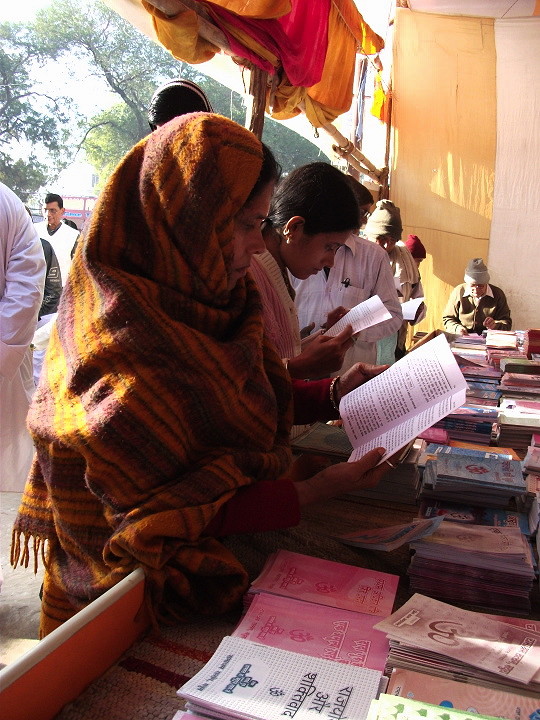
Having spoken to the achars or gurus at Tundla, it was fitting now to speak to some of the shishyas or followers. For instance, the suave Maya Rama, 45, of the Punjab Police in Chandigarh, has been a devotee since twenty years, and his beautiful daughter, Aishwarya, 18, a B. Tech. student, since childhood. “Meditation makes me feel nice and relaxed. I am assured that I am a good human being,” she said. “I also believe that the environment is constantly regenerating and we are helping it in a positive way by meditation. Some of my friends and their parents too are also into this movement. But it would be nice if RSM does some publicity. This movement could be more youthful.”
But Maya Ram didn’t agree. “Well, publicity brings in an element of compulsion and we don’t want that. Let people discover RSM on their own.”
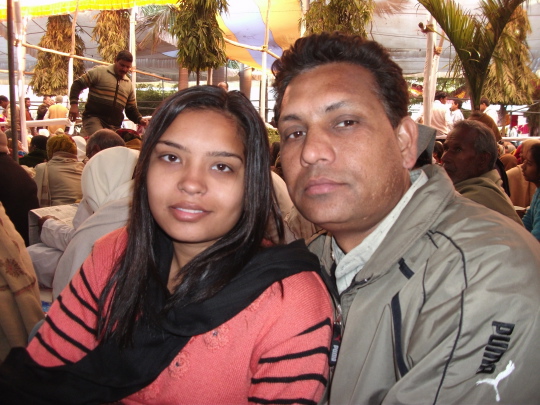
A lone Sikh in the several hundreds thronging the mela, Jasbir Singh, 34, a goldsmith from Amritsar, was at the makeshift canteen out on the street, sipping tea. “This is my first experience of this satsang,” he began. “So…”
Just then a middle-aged couple came up with glasses of tea and wanted to know who I was. When I introduced myself, the man handed me a glass of tea and said, “Later maybe. Not now,” and accosted Jasbir away. Poor man wasn’t able to finish his tea. A journalist is unwanted news for some people.
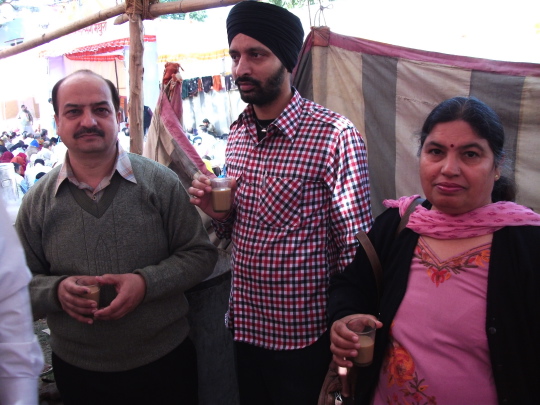
Umakant Sarma, 62, from Bihar, had no such qualms. A lecturer in geography in a Patna College, and associated with RSM for 31 years, he claims to have introduced about a hundred people to RSM. “From Munger, Lakhimserai, Patna. Some of them have come to this mela. My guess is we have about a thousand RSM devotees in the whole of Bihar.” He said that there are no rewards or promotion for members who bring in new people. “But I do get to perform some duties like distributing prasad and drinking water or cooking rotis, cutting vegetables. I love it, doing work for the organization. It gives almost equal happiness as doing meditation. I come here almost every year. In Bihar too, we hold big satsangs like this in December, alternating between Patna and Gaya.”
During his student days in Munger, Umakant learnt about a Hindi professor who was conducting satsangs. “So, one day I took along fifteen friends and attended a satsang at his residence. Since then I’ve never looked back. I still maintain contact with those friends. Some are in the US and Middle East. We share the utter joy that we experience in RSM. It’s indescribable, this feeling.”
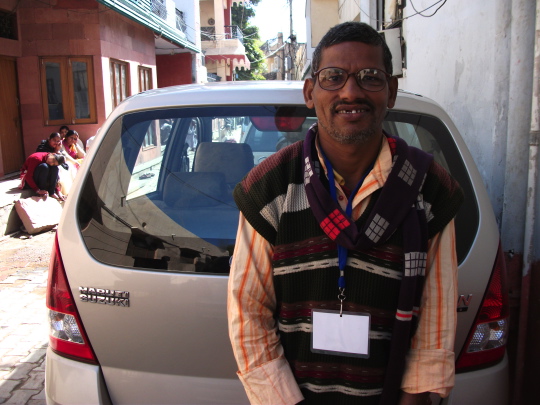
The word ‘indescribable’ is a favorite in RSM lexicon. I heard it once more, this time from a banker, Palav Grego, 28, from Hazaribagh, Bihar. He described RSM not as an organization but as an informal gathering of diverse people brought together by a common wanting-peace. “I have been a satsangi since my birth, probably even before that,” he said and the ring of grandeur in his tone was hard to miss. “You must experience the joy yourself; the joy of meditation, the joy of being with other satsangis…it’s indescribable. You can’t explain it however talented a journalist you are. Can you describe the true experience of tasting a sweet?” Then he said, “Anyway, I am too small a person to be interviewed by you. Sorry.” He refused to be photographed.

Naveen Kumar, 35, a teacher from Pathankot in Punjab, was severely critical of the arrangements. “They should have conducted this outside the city, in an open area where proper shelters could be put up. Here it’s too hot and dusty out on the streets. How can small children tolerate this? And look there, people are drying out their clothes!” He pointed to poles of the marquee near the entrance where saris and dhotis were fluttering
But his wife, Monica, whose father has been with RSM since 1975, who apparently was the moving force for the family to attend this mela, quickly added, “But the philosophy is good.”
“Well…yes, but the arrangements…” Naveen went on, shaking his head.
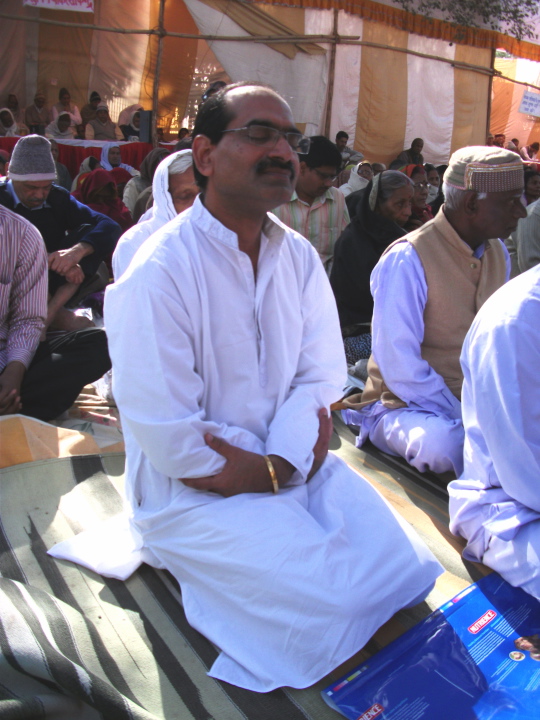
Social, Political and Religious Scenario of the 1800s and 1900s
For the three days of the mela, the town of Mathura reverberated with the hustle and bustle of RSM satsangis-they were out in the markets and temples, shops and restaurants, taking respite from the lectures and meditation sessions. And just 25 kilometers away, a few minutes walk from the grand ISKCON temple in Vrindavan town where Lord Krishna is believed to have played a number of pranks, killed demons and made many a damsel swoon, the director of Vrindavan Research Institute, Dr. Hari Mohan Malviya, said he had not heard of Ramashram Satsang.
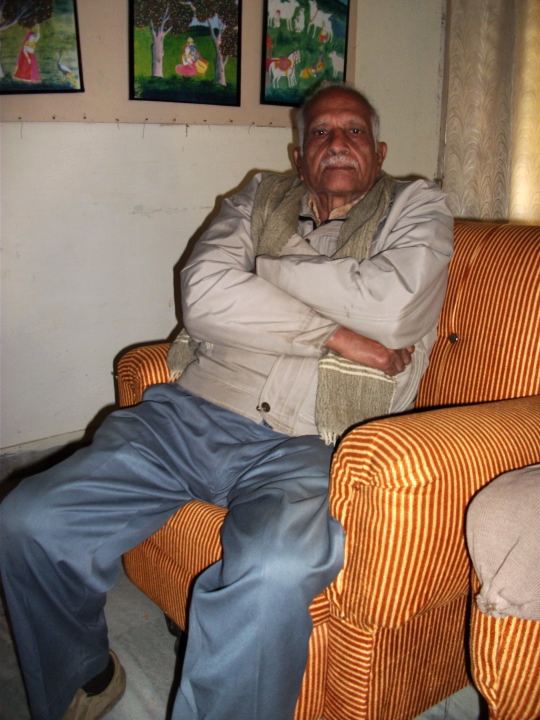
“There are many such organizations in India that call themselves spiritual,” he said. “They get registered as non-profit organizations, rake in money by the bushels from gullible donors and avoid paying taxes.” I recounted him briefly my experience so far of RSM, but he remained skeptical.

Malviya was principal of an Allahabad college and upon retirement, took up this job to ‘do something worthwhile.’ His spirit of camaraderie has endeared him to his staff; they looked happy and relaxed to be working under him. We sat in the lounge outside his office and he thought for a while about what I had said, about what I needed to know, and then started to draw a composite picture of the social, political and religious scenario that prevailed in Northern India in the 1800s and 1900s.
“Those were really heady days of new ideas and reforms, struggle and pain, and small victories and big defeats. It all started with Ram Mohan Roy (1772-1833). He pioneered the Bengal Renaissance for reformation in society and Hinduism. He attacked superstitions, caste system, child marriage, polygamy, and the sati practice where women immolated, or were forced to immolate, themselves in the funeral pyres of their husbands. In fact, he was able to get the British enact a law against sati with the help of William Benting, then Governor of West Bengal. Supported by eminent intellectuals like Debendranath Tagore, he founded the Brahmo Sabha in 1828, the precursor to the Brahmo Samaj or Brahmoism [6] which came into existence as a new religion, distinct from Hinduism, in Calcutta in 1849 (after Roy’s death in 1833).
“Then there was Ishwar Chandra Vidyasagar (1820-1891), litterateur and educationist, who shared Roy’s vision of a casteless society and also propagated widow remarriage. He sought to reform the evils of orthodox Hinduism from within. In fact, although he was from a conservative Brahmin family, he got his son married to a widow.
“Or take the case of Pandit Madan Mohan Malviya (1861-1946), born in Allahabad and graduated from Calcutta. He created the largest university in Asia, the Banares Hindu University, with the help of that great sympathizer of India, Dr. Annie Besant. He was also a freedom fighter and politician. President of the Congress Party four times, he was instrumental in establishing the scouting movement in India and joined Mahatma Gandhi in the freedom struggle movement. A reformer of the caste system, he worked tirelessly for the uplift of backward castes, particularly for their entry into Hindu temples. He was the one who coined our national slogan, ‘Satyameva Jayate’ (Truth Alone Will Triumph).
“Then the celebrated man of letters, Bankim Chandra Chatterjee (1838 – 1894) from West Bengal, stimulated people to think and question through literature. He was the author of Vande Mataram, a poem that stirred the imagination of the entire country so much so that it became the national song, set to tune by none other than the Nobel Laureate, the poet Rabindranath Tagore. The song was drawn from Bankim’s Anandamath (The Abbey of Bliss), a political novel that called for removing the Turko-Afghan Muslim rule of Bengal at that time. In one of his essays, he commented: “There is no serious hope of progress in India except in Hinduism–reformed, regenerated and purified.”
Dr. Malviya considered 1893 as a milestone in the Bengal Renaissance. “That was the year when Swami Vivekananda (1863-1902) lectured to the West at the Chicago Parliament of World Religions. His address regarding the richness and tolerance of Hinduism made a great impact on the assembly, and indeed all over the US. He had in one stroke uplifted Hinduism from the morass it was under in the eyes of the British (because of evils like caste system, dowry, and sati) to become a beacon of spiritual light for the whole world. That success reflected back in India and almost overnight he became a huge personality. He was the first to have brought a successful organizational approach to religion. Service to society was his biggest message [7].
“He did not live even up to 40 years. But see the legacy he left behind. It still stands tall today in the form of the Ramakrishna Mission which operates all over India for social, cultural, educational and relief work-Vivekananda founded the Mission on the principle Atmano Mokshartham Jagat-hitaya cha (for one’s own salvation and for the welfare of the World). Virtually all eminent figures across the political, religious, academic, and societal spectrum-be it Mahatma Gandhi or Rabindranath Tagore, Jamshetji Tata or the Rajas of several kingdoms–hailed him as the leader of modern India, the one who showed our people, particularly the youth, the way forward.”
Dr. Malviya then spoke of the two great opposing contemporaries from Maharashtra, Gopal Krishna Gokhale (1866-1915) and ‘Lokmanya’ Bal Gangadhar Tilak (1856-1920), famed for their contribution to reforming Hinduism and India’s freedom struggle. “Tilak was known for his aggressiveness whereas Gokhale was exactly the opposite, amiable and conciliatory. They and their respective supporters were known as the ‘Garam Dal’ and the ‘Naram Dal’-the hot faction and the soft faction! Mahatma Gandhi leaned towards Gokhale [8] although he also respected Tilak [9].
Next, Dr Malviya dwelt on ‘the greatest of Hindu saints in modern times’ – Swami Dayananda Saraswati (1824-1883), who founded the Arya Samaj [10] religion. “He was born in Gujarat and became the disciple of Swami Virjananda of Mathura who entrusted him the life-long mission of disseminating the knowledge of the Vedas. Although a Gujarati, Swami Dayananda Saraswati wrote his masterly book Satyarth Prakash in Hindi, and it contributed immensely to the Freedom Movement. Not many people know that he was the first to give the clarion call for self rule or Swaraj.”
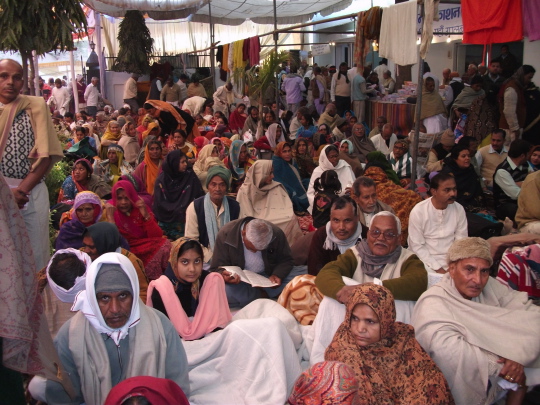
There were many others, said Dr Malviya, who contributed to reform in religion and society. People like Lala Lajpat Rai (1865-1928), the Lion of Punjab, an awe-inspiring freedom fighter, Motilal Nehru (1861-1931) from Kashmir, the progenitor of the Jawaharlal Nehru-Indira Gandhi family, Mahatma Gandhi of course, Rajendra Prasad (1884-1963) from Bihar, who became the first President of India, and Ram Manohar Lohia (1910-1967; eminent freedom fighter and advocate of the backward castes), Hridyanath Kunzru (1887-1978; who led the Indian scouts movement as well as the Servants of India Society founded by Gokhale for several decades), Tej Bahadur Sapru (1875-1949; a great jurist and leader of the Indian Liberal Party), all from Uttar Pradesh….
“The thing is the milieu of that time promoted thinking in new and radical directions. It became a necessity. India had to be revamped in terms of society, religion, politics, and education. We, the present people, owe a lot to those great leaders.”
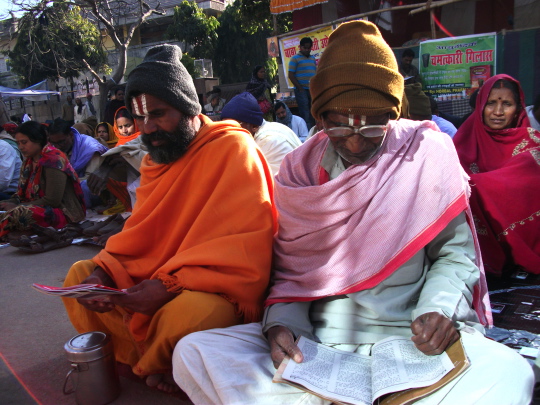
As I prepared to take leave, Dr. Malviya restrained me saying that he wanted to look up a directory that listed spiritual organizations in and around Mathura. We walked to the library building at the back. He got hold of the directory, a booklet actually, of different Vaishno organizations. It was published by his own institute, and there it was, Ramashram Satsang, listed on the last page under Other Religious Organizations. He kept looking at the name and finally declared: “Never heard of it.”
Ramesh Avadhani
Notes
[1] The mystical branch of Islam that is said by some to have pre-dated the rise of Islam in 7th century. Some aspects are believed to be influenced by Buddhism and Hinduism.
[2] The Ten Principles of the Ramashram Satsang Philosophy
1. God is the supreme power with no name or form, and you can choose a name of your liking.
2. To seek him, you need not renounce either the world or the married life; you do not need to live a secluded life nor do you need to become a wanderer. Those living with family and leading a ‘normal’ life can still reach god.
3. In order to attain self-realization, you must find someone who has already attained self-realization and seek his guidance.
4. Bring inner happiness into you life, for it is a divine virtue.
5. Gyan or knowledge brings peace; you will not find it outside. It is within you, so you will need introspection and Satsang to be at peace.
6. You should continue to devote most of your time to your daily activities. However, while practicing Satsang, you should keep your mind clear of all worldly concerns.
7. As a Satsangi (seeker), two activities are very important for you-first, earning an honest living, and second, keeping busy with work.
8. Knowledge is infinite. If your Guru cannot take you to your goal, then seek the guidance of another Guru. However, after finding an Atma-Gyani Guru (self-realized person), you should stay with him.
9. Do all worldly work with a spirit of service, not to rule or to own.
10. Live in this world as a guest. Believe that someone else owns everything in this world. Leave “me and mine”. And learn “you and yours”.
[3] Brahmin [priests and learned], Vaishya [traders], Khastriyas [warriors], and Shudras [menial laborers].
[4] The full story is depicted in one of India’s two great epics, The Ramayana.
[5] An important part of the other great Indian epic, The Mahabharata.
[6] The main features of Brahmoism: God or Singularity is manifest everywhere and in everything, and all beings are created from him. Being exists to be one (again) with God.
Righteous actions alone rule Existence against Chaos. Knowledge of pure Conscience (light within) is the One (Supreme) ruler of Existence with no symbol or intermediary. Respect all creations and beings but never worship them for only Singularity can be worshipped. Do not believe in any scripture or authority, or idols, or avatars of the Supreme.
[7] Swami Vivekananda believed that the essence of Hinduism was best expressed in the Vedanta philosophy, based on the interpretation of Adi Shankara:
Education is the manifestation of perfection already in man. Religion is the manifestation of divinity already in man. Serving man is serving God. Hence each soul is potentially divine. The goal is to manifest this Divinity within by controlling nature, external and internal. One can do this either by work, or worship, or psychic control, or philosophy-by one, or more, or all of these-and be free. This is religion. Doctrines, dogmas, rituals, books, and temples are secondary. Arise, awake and stop not till the goal is reached.
He coined the concept of daridra narayana seva – the service of God in and through poor people. “If there truly is the unity of Brahman underlying all phenomena, then on what basis do we regard ourselves as better or worse, or even as better-off or worse-off, than others?” – he asked. No one can be truly free until all of us are. Even the desire for personal salvation has to be given up, and only tireless work for the salvation of others is the true mark of the enlightened person.
Vivekananda advised his followers to be holy, unselfish and have shraddha (faith). He encouraged the practice of brahmacharya (celibacy). In one of the conversations with his childhood friend Priya Nath Sinha, he attributes his physical and mental strengths as also eloquence to the practice of brahmacharya.
[8] Gokhale founded the ‘Servants of India Society’ for the express purpose of expansion and improvement of the education system in India. He believed that India would transform only when its people became aware of their patriotic and civil duties towards the country as well to one another. “The Servants of India Society will train men prepared to devote their lives to the cause of country in a religious spirit, and will seek to promote, by all constitutional means, the national interests of the Indian people.”
[9] Tilak was known as the “Father of the Indian Unrest” a phrase coined by the British and purported to be derogatory. He was one of the strongest advocates of swaraj or self-rule in Indian consciousness and urged Mahatma Gandhi to adopt any and all means, even violence, to gain it. Tilak coined the memorable slogan: “Swaraj is my birthright, and I shall have it!” And it was he who transformed the household worship of Lord Ganesha into a public celebration in Maharashtra.
[10] The Arya Samaj, a “universal society” based on the authority of the Vedas, is against idol worship, animal sacrifice, ancestor worship, pilgrimages, priest craft, offerings made in temples, the caste system, untouchability, child marriages and discrimination against women because all these lack Vedic sanction. It also discourages dogma and symbolism and is skeptical of beliefs that run contrary to common sense and logic. Aum or Om is considered by the Arya Samaj to be the highest and most proper name of God.
© 2011 Ramesh Avadhani/Religioscope for the article.
All pictures by the author, © 2011 Ramesh Avadhani.